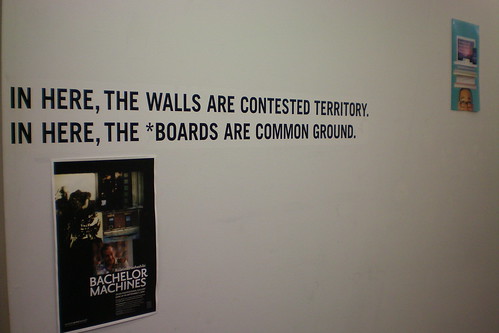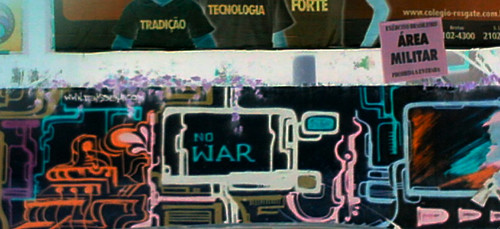Trans-Border Tools
Já havia postado sobre o “Trans-Border Tools” do Electronic Disturbance Theater. No texto (em discussão para apresentação no simpósio “Violence, Techonoly and Public Intervention” do NetBehavior), Trans-border Tools by EDT, os autores apresentam a ferramenta e os motivos que levaram a sua proposição. O título da apresentação é “The Transborder Immigrant Tool: Violence, Solidarity and Hope in Post-NAFTA Circuits of Bodies *Electr(on)/ic* A talk by the Electronic Disturbance Theater.
Leiam o texto. Ele apresenta uma interessante articulação de questões caras ao debate contemporâneo sobre a “internet das coisas” e as mídias locativas, como a dimensão filosófica e política do andar, as geografias sensíveis, as fronteiras polissêmicas, a geopolítica mundial, as novas tecnologias e a arte. Podemos pensar aqui nas questões que tenho levantado, neste Carnet e nos últimos artigos, sobre as novas territorializações com as tecnologias de localização e da mobilidade (particularmente celulares e GPS), sobre o controle informacional na nova relação espaço físico e eletrônico, sobre os novos sentidos dos lugares e dos não-lugares, como essas zonas de transição entre fronteiras, o “no man’s land”, etc. O texto mostra como uma ferramenta de controle informacional (celular, GPS e softwares) pode ser usada para ajudar os “desterritorializados”, aqueles que buscam superar as bordas, as fronteiras dos Estados e, mais ainda, as barreiras sociais, políticas e raciais. Acho que o “Trans-Border” é um excelente exemplo de articulação das midias locativas com a arte e a política. Ele coloca em evidência os problemas territoriais (físicos, políticos, subjetivos e informacionais) da sociedade contemporânea. O texto faz referência ao Brasil pelos trabalhos de Lygia Clark e de Augusto Boal. Abaixo alguns trechos:
“The U.S.-Mexico border has rewritten and been rewritten by the imaginative geographies of the literal continental corridor. As Gloria Anzaldua writes in Borderlands / La Frontera: ‘The U.S.-Mexican border es una herida abierta [is an open wound] where the Third World grates against the first and bleeds. And before a scab forms it hemorrhages again, the lifeblood of two worlds merging to form a third country – a border culture.’ A deep archive and repertoire of suspect movement choreographs American -isms that hyperextend/hypertext beyond the United States to cast shadows of negative value on certain bodies, directional flows, and cognitive/head maps. To add injury to insult, vertiginous ecologies and narco-reterritoralizations compound the dangers of contemplating border landscapes as continuity (versus contingency).
“The Tool The Transborder Immigrant Tool is a project by the Electronic Disturbance Theater with the aim of reappropriating widely available technology to be used as a form of humanitarian aid. The tool consists of an inexpensive cell phone, with a Global Positioning Satellite (GPS) chip, and a custom piece of software. The software will direct the user of the phone toward the nearest aid site, be that water, first aid or law enforcement, along with other contextual navigational information. This is accomplished by a Java based application written by Brett Stalbaum which accesses the phone’s ability to receive GPS information without needing to send out data which may allow the user to be located and without needing phone service.”
“The Transborder Immigrant Tool can be seen as part of a larger shift from Tactical Media to Tactical Biopolitics. While media artists of the late nineties and early two thousands were often concerned with the political potentials opened up by cheaper access to media technologies, we are interested in the political potential opened up by technologies which can serve to improve people’s lives directly, including medical technologies and safety devices such as GPS tools. The upcoming Digital Art and Culture conference’s title ‘after media’ sums up well the contemporary media artist’s desire to take their work off of the screen and back into the world. Biopolitics can be thought of as resistance to control over our daily lives, and as such we see the shift embodied in the Transborder Immigrant Tool away from media and towards public interventions which seek to change the very conditions of life and death which are created by biopower”
“In addition to the navigational capabilities of the Tool, we have recently added another module to the software in order shift the dialog further towards one of hospitality. As the user walks with the tool, after a given temporal interval, a few lines of poetry will begin to play. With this gesture we can provide a bit of poetic sustenance, to enact a space of hospitality and to welcome the traveler into a new space.”

“Brett Stalbaum has recently begun a new website, Walkingtools.net, with the aim of sharing frameworks and practices among locative media artists. Here, the Transborder Immigrant Tool is one example of this model that includes a Base Layer XML Schema, an API, an Authoring Layer and a Project Layer. At the Authoring Layer are tools such as the Transborder Deployer, which will allow organizations we collaborate with to install our software on their own phones. Our hope for the project is that it may enable groups we are working with to be able to access these inexpensive phones and install our software themselves. In the case of Border Angels, this could facilitate the ease of handing a new volunteer a cell phone with our software on it and they could refill the water caches themselves, allowing many more volunteers to participate in the humanitarian effort. Brett’s hope for Walkingtools.net is that it will allow locative media artists to expand their practices in new directions instead of needing to reinvent the wheel or make the plumbing for every project they embark on.”

